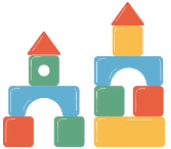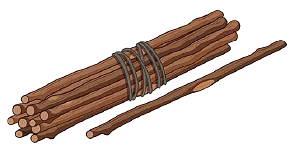Word Problem: Division - 1 | Mathematics for Class 3 PDF Download
Exercise 1: Lexie’s Art Materials
Lexie has a lot of art materials. She needs to organize all these materials into containers. Answer the questions below:
Answer the questions below:
Q.1. She counted her crayons and found out that she has 80 crayons which she will place in crayon boxes. Every crayon box can contain 8 crayons. How many crayon boxes does she need?
Total crayons = 80
Capacity of each box = 8 crayons
Number of boxes = 80 ÷ 8
Compute: 80 ÷ 8 = 10
Answer: 10 crayon boxes
Q.2. Besides the piles of white paper was a stack of 700 sheets of used paper. She wants to place it in boxes for recycling. If every box can contain 100 sheets, how many boxes does she need?
Total sheets = 700
Capacity of each box = 100 sheets
Number of boxes = 700 ÷ 100
Compute: 700 ÷ 100 = 7
Answer: 7 boxes
Q.3. Lexie’s younger brother helped pick up all the paper clips in Lexie’s room. He was able to collect 81 paper clips. If he wants to distribute the paper clips in 9 boxes, write an equation showing how many paper clips each box will contain.
Total paper clips = 81
Number of boxes = 9
Clips per box = 81 ÷ 9
Compute: 81 ÷ 9 = 9
Q.4. 3 piles of clean white papers were stacked in the corner of her room. She decided to place these papers in paper envelopes which can hold 10 papers each. How many paper envelopes does she need if she has 120 clean white papers?
Total papers = 120
Capacity of each envelope = 10 papers
Number of envelopes = 120 ÷ 10
Compute: 120 ÷ 10 = 12
Answer: 12 envelopes
Q.5. Lexie’s spent 2 hours gathering all of her watercolor paintings. She thought of placing an equal number of paintings in four of the rooms in the house. If Lexie has 32 watercolor paintings, how many paintings will be placed in each of the four rooms?

Total paintings = 32
Number of rooms = 4
Paintings per room = 32 ÷ 4
Compute: 32 ÷ 4 = 8
Answer: 8 paintings per room
Exercise 2: Shiela’s Christmas Gifts
Shiela has started writing a list of the gifts that she plans to give to her family and friends this Christmas.
 Answer the questions below:
Answer the questions below:
Q.1. For her classmates, she made colorful paper stars which will be placed in small clear bottles. She was able to prepare 45 paper stars. How many stars will be placed in each bottle if Shiela has 9 classmates?
Total paper stars = 45
Number of bottles = 9
Stars per bottle = 45 ÷ 9
Compute: 45 ÷ 9 = 5
Answer: 5 stars per bottle
Q.2. Allan, Shiela’s brother, likes to play with blocks. Shiela repainted Allan’s old blocks in different colors. If Allan has 49 blocks and there are 7 blocks for every color of paint used, how many colors did Shiela use?
Total blocks = 49
Blocks per color = 7
Number of colors = 49 ÷ 7
Compute: 49 ÷ 7 = 7
Answer: 7 colors
Q.3. It has been tradition in Shiela’s home to hang a sock above the fireplace for each member of the family. This year, she placed a cinnamon ball every day in the socks for 5 of her family members. Write an equation showing how many days she can she do this if she bought 50 cinnamon balls?

Total cinnamon balls = 50
Family members = 5
Days of use = 50 ÷ 5
Compute: 50 ÷ 5 = 10
Answer: 10 days
Q.4. Shiela has 6 neighbors who like to collect animal drawings. Shiela has a talent for drawing, so she drew 54 animals on pieces of paper that are 10 inches wide and 10 inches tall. If she plans to give the same number of animal drawings to her neighbors, how many drawings will each neighbor receive?
Total drawings = 54
Number of neighbors = 6
Drawings per neighbor = 54 ÷ 6
Compute: 54 ÷ 6 = 9
Answer: 9 drawings per neighbor
Q.5. Aside from drawing animals, Shiela is fond of painting flowers. She can name 12 different types of flowers! If she has 18 paintings of flowers, how many paintings can she give to each of her two grandmothers?

Total paintings = 18
Number of grandmothers = 2
Paintings per grandmother = 18 ÷ 2
Compute: 18 ÷ 2 = 9
Answer: 9 paintings per grandmother
Exercise 3: Christian’s National Park Activities
Christian and his parents went to Mount Falton National Park for the weekend. They were welcomed warmly by the rangers who invite volunteers and call them “earth keepers”.
 Answer the questions below:
Answer the questions below:
Q.1. The junior ranger asked Christian to help him place 420 seedlings in packets. If every packet needs to contain 7 seeds, how many packets do they need?
Total seeds = 420
Seeds per packet = 7
Number of packets = 420 ÷ 7
Compute: 420 ÷ 7 = 60
Answer: 60 packets
Q.2. Christian’s father and the senior ranger gathered firewood as they walked the 5 miles towards the lake. If every sack can contain 20 pieces of wood, how many sacks were they able to fill if they gathered 80 pieces of wood?
Total wood pieces = 80
Pieces per sack = 20
Number of sacks = 80 ÷ 20
Compute: 80 ÷ 20 = 4
Answer: 4 sacks
Q.3. Sunday morning was spent making wood carvings which can be sold as souvenirs to tourists. They were placed in shelves that can contain 8 wood carvings at a time. If 56 wood carvings were displayed, write an equation to determine how many shelves were filled with carvings.
Total carvings = 56
Carvings per shelf = 8
Number of shelves = 56 ÷ 8
Compute: 56 ÷ 8 = 7
Answer: 7 shelves
Q.4. Christian’s mother prepared lemonade. Every pitcher of lemonade can fill 5 glasses. If she was able to serve 30 glasses of lemonade in 2 hours, how many pitchers of lemonade did she prepare?
Total glasses = 30
Glasses per pitcher = 5
Number of pitchers = 30 ÷ 5
Compute: 30 ÷ 5 = 6
Answer: 6 pitchers
Q.5. Christian and the junior ranger brought a bag of 140 nails as they visited every station assigned to the junior ranger. If they left exactly 7 nails in every station they visited, how many stations did they visit?
Total nails = 140
Nails per station = 7
Number of stations = 140 ÷ 7
Compute: 140 ÷ 7 = 20
Answer: 20 stations
|
18 videos|120 docs|25 tests
|
FAQs on Word Problem: Division - 1 - Mathematics for Class 3
| 1. How do I divide two whole numbers? |  |
| 2. What is the difference between division and multiplication? |  |
| 3. Can you divide fractions? |  |
| 4. How do you divide a decimal number by a whole number? |  |
| 5. Can you divide by zero? |  |
















